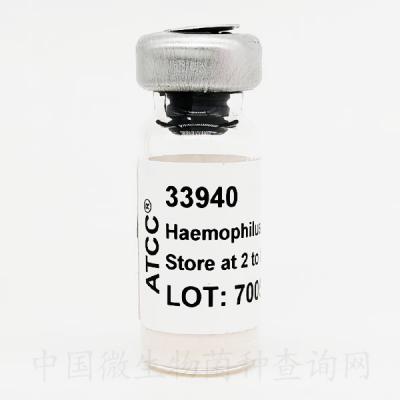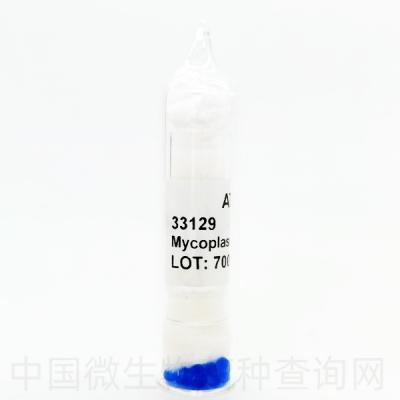29343
29343™
Product category
Bacteria
Strain designation
M129-B170
Type strain
No
Isolation source
Avirulent mutant, derived from ATCC 29342
Applications
Infectious disease research
Respiratory disease research
Product format
Freeze-dried
Storage conditions
2°C to 8°C
General
Specific applications
Respiratory research
Preceptrol
No
Handling information
Medium
ATCC Medium 988: Spiroplasma medium SP-4
Temperature
37°C
Atmosphere
Broth: Aerobic
Plates: 5% CO2
Handling procedure
Follow instructions as suggested for the culturing of Mollicutes:
PROCEDURES FOR PROPAGATING MOLLICUTES
Open the vial according to the enclosed instructions.
Using a Pasteur or 1.0 mL pipette, withdraw approximately 0.5 to 1.0 mL from a tube containing 2.5 mL. Rehydrate the entire pellet.
Aseptically transfer this aliquot back into the tube. Mix well.
Make serial dilutions by transferring 0.25 mL from the original tube to a tube containing 2.25 mL. Repeat process by transferring 0.25 mL from the second to a third tube, etc. Dilutions are important, not only for titration purposes, but also to keep culture in varying stages of growth. Many strains will die out rapidly once acid or alkaline conditions are reached. It is recommended to prepare several dilutions from the initial tube as the cryoprotectant used in the freeze-drying process often inhibits growth.
Use an uninoculated tube of broth to serve as a control.
Plates may be inoculated to check colonial morphology. You can also spot each dilution on the surface of plate (4 or more/plate) to determine the number of colony-forming units. However, not all strains do well on solid medium.
Incubate all tubes and plates under the recommended conditions and appropriate temperature. The time necessary for growth will vary from strain to strain. Growth on plates generally requires additional incubation.
Depending on the medium used, growth will be indicated by increasing turbidity, a color change, or both.
Tubes are incubated aerobically, plates are incubated in an atmosphere of 5% CO2. The incubation temperature is 37°C.
Mycoplasma pneumoniae strains are very slow growing and produce a very light turbidity. It usually takes at least seven days for the first tube to start showing growth. Growth is easily recognized by an indicator change from red to orange to yellow. The cells are best transferred when the medium is orange. After medium changes to yellow, cells have started to die.
For long term storage of Mycoplasma pneumoniae, freeze-drying or freezing is recommended. Liquid nitrogen storage is the best method. Optimally grown cells are centrifuged at 9000 rpm for 30 minutes, the supernatant poured off, and the packed cells resuspended in a smaller amount of #988 broth. To this, add an equal amount of sterile 20% glycerol as a cryoprotectant. This suspension is aliquoted into small plastic vials and stored at -70°C or below.
Handling notes
Additional information on this culture is available on the ATCC® web site at www.atcc.org.
History
Deposited as
Mycoplasma pneumoniae Somerson et al.
Depositors
WA Clyde
Legal disclaimers
Intended use
This product is intended for laboratory research use only. It is not intended for any animal or human therapeutic use, any human or animal consumption, or any diagnostic use.
Warranty
The product is provided 'AS IS' and the viability of ATCC® products is warranted for 30 days from the date of shipment, provided that the customer has stored and handled the product according to the information included on the product information sheet, website, and Certificate of Analysis. For living cultures, ATCC lists the media formulation and reagents that have been found to be effective for the product. While other unspecified media and reagents may also produce satisfactory results, a change in the ATCC and/or depositor-recommended protocols may affect the recovery, growth, and/or function of the product. If an alternative medium formulation or reagent is used, the ATCC warranty for viability is no longer valid. Except as expressly set forth herein, no other warranties of any kind are provided, express or implied, including, but not limited to, any implied warranties of merchantability, fitness for a particular purpose, manufacture according to cGMP standards, typicality, safety, accuracy, and/or noninfringement.
Disclaimers
This product is intended for laboratory research use only. It is not intended for any animal or human therapeutic use, any human or animal consumption, or any diagnostic use. Any proposed commercial use is prohibited without a license from ATCC.
While ATCC uses reasonable efforts to include accurate and up-to-date information on this product sheet, ATCC makes no warranties or representations as to its accuracy. Citations from scientific literature and patents are provided for informational purposes only. ATCC does not warrant that such information has been confirmed to be accurate or complete and the customer bears the sole responsibility of confirming the accuracy and completeness of any such information.
This product is sent on the condition that the customer is responsible for and assumes all risk and responsibility in connection with the receipt, handling, storage, disposal, and use of the ATCC product including without limitation taking all appropriate safety and handling precautions to minimize health or environmental risk. As a condition of receiving the material, the customer agrees that any activity undertaken with the ATCC product and any progeny or modifications will be conducted in compliance with all applicable laws, regulations, and guidelines. This product is provided 'AS IS' with no representations or warranties whatsoever except as expressly set forth herein and in no event shall ATCC, its parents, subsidiaries, directors, officers, agents, employees, assigns, successors, and affiliates be liable for indirect, special, incidental, or consequential damages of any kind in connection with or arising out of the customer's use of the product. While reasonable effort is made to ensure authenticity and reliability of materials on deposit, ATCC is not liable for damages arising from the misidentification or misrepresentation of such materials.






